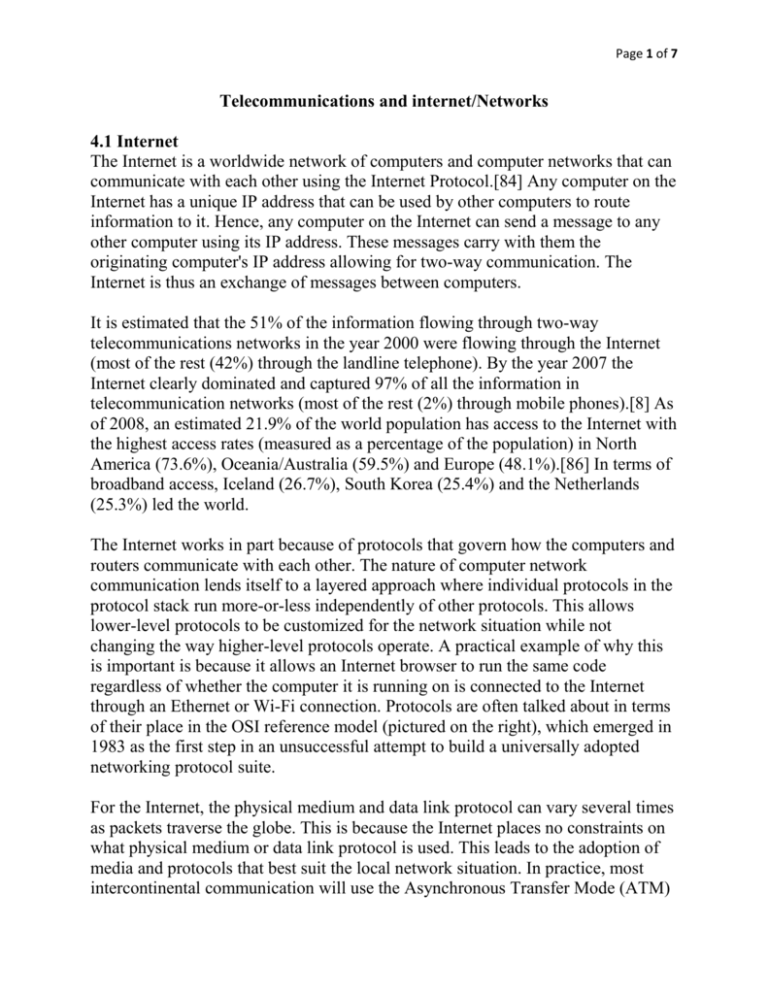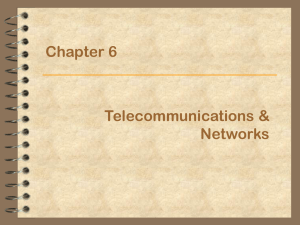Telecommunications and internet/Networks 4.1 Internet The Internet
advertisement

Page 1 of 7 Telecommunications and internet/Networks 4.1 Internet The Internet is a worldwide network of computers and computer networks that can communicate with each other using the Internet Protocol.[84] Any computer on the Internet has a unique IP address that can be used by other computers to route information to it. Hence, any computer on the Internet can send a message to any other computer using its IP address. These messages carry with them the originating computer's IP address allowing for two-way communication. The Internet is thus an exchange of messages between computers. It is estimated that the 51% of the information flowing through two-way telecommunications networks in the year 2000 were flowing through the Internet (most of the rest (42%) through the landline telephone). By the year 2007 the Internet clearly dominated and captured 97% of all the information in telecommunication networks (most of the rest (2%) through mobile phones).[8] As of 2008, an estimated 21.9% of the world population has access to the Internet with the highest access rates (measured as a percentage of the population) in North America (73.6%), Oceania/Australia (59.5%) and Europe (48.1%).[86] In terms of broadband access, Iceland (26.7%), South Korea (25.4%) and the Netherlands (25.3%) led the world. The Internet works in part because of protocols that govern how the computers and routers communicate with each other. The nature of computer network communication lends itself to a layered approach where individual protocols in the protocol stack run more-or-less independently of other protocols. This allows lower-level protocols to be customized for the network situation while not changing the way higher-level protocols operate. A practical example of why this is important is because it allows an Internet browser to run the same code regardless of whether the computer it is running on is connected to the Internet through an Ethernet or Wi-Fi connection. Protocols are often talked about in terms of their place in the OSI reference model (pictured on the right), which emerged in 1983 as the first step in an unsuccessful attempt to build a universally adopted networking protocol suite. For the Internet, the physical medium and data link protocol can vary several times as packets traverse the globe. This is because the Internet places no constraints on what physical medium or data link protocol is used. This leads to the adoption of media and protocols that best suit the local network situation. In practice, most intercontinental communication will use the Asynchronous Transfer Mode (ATM) Page 2 of 7 protocol (or a modern equivalent) on top of optic fiber. This is because for most intercontinental communication the Internet shares the same infrastructure as the public switched telephone network. At the network layer, things become standardized with the Internet Protocol (IP) being adopted for logical addressing. For the World Wide Web, these "IP addresses" are derived from the human readable form using the Domain Name System (e.g. 72.14.207.99 is derived from www.google.com). At the moment, the most widely used version of the Internet Protocol is version four but a move to version six is imminent.[89] At the transport layer, most communication adopts either the Transmission Control Protocol (TCP) or the User Datagram Protocol (UDP). TCP is used when it is essential every message sent is received by the other computer whereas UDP is used when it is merely desirable. With TCP, packets are retransmitted if they are lost and placed in order before they are presented to higher layers. With UDP, packets are not ordered or retransmitted if lost. Both TCP and UDP packets carry port numbers with them to specify what application or process the packet should be handled by. Because certain application-level protocols use certain ports, network administrators can manipulate traffic to suit particular requirements. Examples are to restrict Internet access by blocking the traffic destined for a particular port or to affect the performance of certain applications by assigning priority. Above the transport layer, there are certain protocols that are sometimes used and loosely fit in the session and presentation layers, most notably the Secure Sockets Layer (SSL) and Transport Layer Security (TLS) protocols. These protocols ensure that data transferred between two parties remains completely confidential. Finally, at the application layer, are many of the protocols Internet users would be familiar with such as HTTP (web browsing), POP3 (e-mail), FTP (file transfer), IRC (Internet chat), BitTorrent (file sharing) and XMPP (instant messaging). Voice over Internet Protocol (VoIP) allows data packets to be used for synchronous voice communications. The data packets are marked as voice type packets and can be prioritized by the network administrators so that the real-time, synchronous conversation is less subject to contention with other types of data traffic which can be delayed (i.e. file transfer or email) or buffered in advance (i.e. audio and video) without detriment. That prioritization is fine when the network has sufficient capacity for all the VoIP calls taking place at the same time and the network is enabled for prioritization i.e. a private corporate style network, but the Page 3 of 7 Internet is not generally managed in this way and so there can be a big difference in the quality of VoIP calls over a private network and over the public Internet. 4.2 Local area networks and wide area networks Despite the growth of the Internet, the characteristics of local area networks (LANs)--computer networks that do not extend beyond a few kilometers--remain distinct. This is because networks on this scale do not require all the features associated with larger networks and are often more cost-effective and efficient without them. When they are not connected with the Internet, they also have the advantages of privacy and security. However, purposefully lacking a direct connection to the Internet does not provide assured protection from hackers, military forces, or economic powers. These threats exist if there are any methods for connecting remotely to the LAN. Wide area networks (WANs) are private computer networks that may extend for thousands of kilometers. Once again, some of their advantages include privacy and security. Prime users of private LANs and WANs include armed forces and intelligence agencies that must keep their information secure and secret. In the mid-1980s, several sets of communication protocols emerged to fill the gaps between the data-link layer and the application layer of the OSI reference model. These included Appletalk, IPX, and NetBIOS with the dominant protocol set during the early 1990s being IPX due to its popularity with MS-DOS users. TCP/IP existed at this point, but it was typically only used by large government and research facilities. As the Internet grew in popularity and its traffic was required to be routed into private networks, the TCP/IP protocols replaced existing local area network technologies. Additional technologies, such as DHCP, allowed TCP/IP-based computers to self-configure in the network. Such functions also existed in the AppleTalk/ IPX/ NetBIOS protocol sets. Whereas Asynchronous Transfer Mode (ATM) or Multiprotocol Label Switching (MPLS) are typical data-link protocols for larger networks such as WANs; Ethernet and Token Ring are typical data-link protocols for LANs. These protocols differ from the former protocols in that they are simpler, e.g., they omit features such as quality of service guarantees, and offer collision prevention. Both of these differences allow for more economical systems. Page 4 of 7 Despite the modest popularity of IBM Token Ring in the 1980s and 1990s, virtually all LANs now use either wired or wireless Ethernet facilities. At the physical layer, most wired Ethernet implementations use copper twisted-pair cables (including the common 10BASE-T networks). However, some early implementations used heavier coaxial cables and some recent implementations (especially high-speed ones) use optical fibers. When optic fibers are used, the distinction must be made between multimode fibers and single-mode fibers. Multimode fibers can be thought of as thicker optical fibers that are cheaper to manufacture devices for, but that suffers from less usable bandwidth and worse attenuation – implying poorer long-distance performance. 4.3 How Telecommunications Have Evolved Over Time While traditional telecommunications networks have allowed us to cross barriers associated with time and distance, the new multimedia realm is allowing us to include vital physical cues in the information stream, introducing a physical reality into the world of electronic communications, goods, and services. Not surprisingly, some of the industries that are being most radically revolutionized are those that deal with the human senses, including entertainment, health care, education, advertising, and, sadly, warfare. Simply put, technology changes your way and pace of life. While traditional telecommunications networks have allowed us to cross barriers associated with time and distance, the new multimedia realm is allowing us to include vital physical cues in the information stream, introducing a physical reality into the world of electronic communications, goods, and services. Not surprisingly, some of the industries that are being most radically revolutionized are those that deal with the human senses, including entertainment, health care, education, advertising, and, sadly, warfare. Simply put, technology changes your way and pace of life. This sample chapter from Telecommunications Essentials presents the big picture of the telecommunications revolution. In recent years, the word telecommunications has been used so often, and applied in so many situations, that it has become part of our daily lexicon, yet its definition remains elusive. So, let's start with a definition. The word telecommunications has its roots in Greek: tele means "over a distance," and communicara means "the ability to share." Hence, telecommunications literally means "the sharing of Page 5 of 7 information over a distance." Telecommunications is more than a set of technologies, it's more than an enormous global industry (estimated to be US$2.5 trillion), it's more than twenty-first-century business and law that is being recreated to accommodate a virtual world, and it's more than a creator and destroyer of the state of the economy. Telecommunications is a way of life. Telecommunications affects how and where you do everything—live, work, play, socialize, entertain, serve, study, teach, rest, heal, and protect. Telecommunications has served a critical role in shaping society and culture, as well as in shaping business and economics. It is important to examine telecommunications from the broadest perspective possible to truly appreciate the depth and complexity of this field and thereby understand the opportunities it affords. The best way to learn to "think telecom" is to quickly examine how it is changing both business and lifestyle. Throughout the 1980s and 1990s, much of the IT&T (information technologies and telecommunications) industry's focus was on how to reengineer the likes of financial institutions, manufacturing, retail, service, and government. These technology deployments were largely pursued and justified on the grounds of reducing costs and enhancing competitiveness by speeding communications. Today, we are shifting our focus to another set of objectives: Our technology deployments are targeted at supporting not just the needs of a business enterprise, but also those of the consumers. The revolution in integrated media is transforming all aspects of human activity related to communication and information. We are moving to computer-based environments that support the creation, sharing, and distribution of multimodal information. Whereas traditional telecommunications networks have allowed us to cross barriers associated with time and distance, the new multimedia realm is allowing us to include vital physical cues in the information stream, introducing a physical reality into the world of electronic communications, goods, and services. Not surprisingly, some of the industries that are being most radically revolutionized are those that deal with the human senses, including entertainment, health care, education, advertising, and, sadly, warfare. In each of these key sectors, there are telecommunications solutions that address the business need, reduce costs, or enhance operations by speeding business processes and aiding communications. These industries are also examining how to virtualize their products and/or services—that is, how to apply telecommunications to support electronic services targeted at the consumers of that industry's products. Not Page 6 of 7 surprisingly, changing the way you attend a class, see a doctor, watch a movie, get a date, shop for software, take a cruise, and stay in touch creates significant changes in how you use your time and money. Simply put, technology changes your way and pace of life. This chapter presents the big picture of the telecommunications revolution, and the rest of the book gives greater detail about the specific technologies and applications that will comprise the telecommunications future. Changes in Telecommunications A quick orientation of how emerging technologies are affecting industries and lifestyle highlights the importance of understanding the principles of telecommunications, and, hopefully, to inspire you to "think telecom." The changes discussed here are ultimately very important to how telecommunications networks will evolve and to where the growth areas will be. An enormous amount of the activity driving telecommunications has to do with the emergence of advanced applications; likewise, advances in telecommunications capabilities spur developments in computing platforms and capabilities. The two are intimately and forever intertwined. The following sections discuss some of the changes that are occurring in both telecommunications and in computing platforms and applications, as well as some of the changes expected in the next several years. Incorporating Human Senses in Telecommunications Telecommunications has allowed a virtual world to emerge—one in which time and distance no longer represent a barrier to doing business or communicating— but we're still lacking something that is a critical part of the human informationprocessing realm. The human mind acts on physical sensations in the course of its information processing; the senses of sight, sound, touch, and motion are key to our perception and decision making. Developments in sensory technologies and networks will allow a new genre of sensory reality to emerge, bridging the gap between humans and machines. One of the most significant evolutions occurring in computing and communications is the introduction of the human senses into electronic information streams. The following are a few of the key developments in support of this more intuitive collaborative human–machine environment: Computers are now capable of hearing and speaking, as demonstrated by Tellme, a popular U.S. voice-activated service that responds to defined voice prompts and provides free stock quotes, weather information, and entertainment guides to 35,000 U.S. cities. Page 7 of 7 The capability to produce three-dimensional sound through digital mastery—a technology called "virtual miking"—is being developed at the University of Southern California's Integrated Media Systems Center. Virtual touch, or haptics, enables a user to reach in and physically interact with simulated computer content, such as feeling the weight of the Hope diamond in your hand or feeling the fur of a lion. Two companies producing technology in this area are SensAble Technologies and Immersion Corporation. They are producing state-of-the-art force feedback, whole-hand sensing, and real-time 3D interaction technologies, and these hardware and software products have a wide range of applications for the manufacturing and consumer markets, including virtual-reality job training, computer-aided design, remote handling of hazardous materials, and "touch" museums. The seduction of smell is also beginning to find its way into computers, allowing marketers to capitalize on the many subtle psychological states that smell can induce. Studies show that aromas can be used to trigger fear, excitement, and many other emotions. Smell can be used to attract visitors to Web sites, to make them linger longer and buy more, to help them assimilate and retain information, or to instill the most satisfying or terrifying of emotional states (now that's an interactive game!). Three companies providing this technology today are Aromajet, DigiScents, and TriSenx. Aromajet, for example, creates products that address video games, entertainment, medical, market research, personal and home products, and marketing and point of sales applications. The visual information stream provides the most rapid infusion of information, and a large portion of the human brain is devoted to processing visual information. To help humans process visual information, computers today can see; equipped with video cameras, computers can capture and send images, and can display highquality entertainment programming. The visual stream is incredibly demanding in terms of network performance; thus, networks today are rapidly preparing to enable this most meaningful of information streams to be easily distributed.



